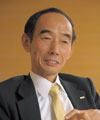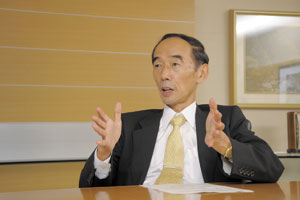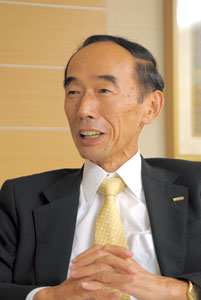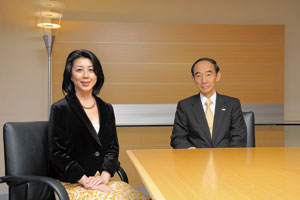 |
|
|
|
|
|
View from the Top Vol. 8, No. 12, pp. 1–4, Dec. 2010. https://doi.org/10.53829/ntr201012tp1  Responding Quickly to a Fast-changing Market with Extensive and Compelling ServicesOverviewFaced with a decline in network revenues, NTT Communications is proposing new technologies and business formats. We talked with Akira Arima, newly appointed President and Chief Executive Officer of NTT Communications, about what the company needs to do to continue its role as a valued firm in a market undergoing a radical transformation. Building relationships—Mr. Arima, has your life changed since becoming president of NTT Communications? Yes, I think so. For one thing, it has become even more difficult to make time for myself compared with my days as vice president. But my time has been well spent as I have been visiting customers to offer them my greetings on the occasion of my appointment and have been engaging in very fruitful conversations with them. This kind of relationship building can only be done right now, but I believe it can lead to great opportunities. The decline in network revenues from traditional sources like telephone and leased lines is accelerating, reflecting an upheaval in our revenue base, and to be frank, I realize that I have taken up this position during tough times. The market environment and technology trends are changing rapidly, requiring us to be quick and nimble in our response. But we can’t just keep up with market trends—we must also revolutionize our business models from the customer’s viewpoint. At present, the revenue base of NTT Communi-cations (NTT Com) is clearly associated with the domestic network business. However, if we take a hard look at the entire domestic market, we can observe social changes like the aging society with fewer children that we have never experienced before. If we fail to accurately and rapidly respond to these changes and build a revenue base in new fields, it might be hard to envision a bright future for NTT Com. Against this background, the NTT Com Group is working to fortify corporate business, expand global business, and shift toward upper-layer Internet business based on its “Vision 2010” growth strategy. To fortify our corporate-oriented business, we are focusing our attention on information and communications technology (ICT) solutions, especially in the area of cloud computing. To expand our global business, we are helping our customers to do just that, namely, to expand their business in diverse ways throughout the world. And finally, to shift toward Internet business, we are looking at video delivery and the provision of applications and other services via the network.
Moving forward with “Vision 2010”—Could you give us some examples of how you are fortifying corporate business? From the start, we have been providing state-of-the-art technologies as part of our corporate services. At present, we are concentrating our efforts in the cloud computing business. Our customers are beginning to realize that cloud computing services can provide them with much flexibility in their operations at a reasonable price and minimal load. But they also demand that cloud computing provide high-quality reliable services, and other companies are of course working to win their business. It is therefore imperative that we take the initiative and respond quickly and appropriately to our customers’ needs. Under these conditions, NTT Com has created the BizCITY service brand as a way of fulfilling its role of solving its customers’ business problems. Through BizCITY, we aim to provide economical business environments in which our customers can work securely and conveniently anytime and anywhere. Applications are, of course, a big part of BizCITY, but the aim here is to provide a full layer of services in a safe and secure manner at the high level of quality for which Japan is known. This includes a platform to support those applications and a network that should more appropriately be called a lifeline. BizCITY provides a one-stop solution from consulting to operation and maintenance: it should be thought of as a secure platform that can meet diverse customer needs. A cloud can be used in different ways, however, depending on the user, and for this reason, a variety of applications have already been prepared; these can be broadly divided into two types of services. The first is the private cloud service that provides a dedicated cloud platform for the customer’s core systems featuring high reliability and flexible peak response. The second is the public cloud service that customers can use safely and securely at low cost only when needed and in only the amount needed. —NTT Com also provides services to meet customer needs in many countries around the world. What gave birth to the company’s global services? We have been expanding our datacenter and hosting business on a global basis through our subsidiaries and offices in regions throughout the world. This is because our clients’ businesses are also going global, and if the services that we offer in various countries and regions were not the same, they would no doubt be difficult to use. Since it’s now becoming possible for users to use ICT and networks without having to be concerned with location, it’s natural for clients to expect the same quality in services regardless of where in the world they may be. It is clear that if the way of using ICT depended on location, work would be more difficult to perform. As Japanese companies become increasingly global, NTT Com will support them through ICT. At present, we are adjusting the content of our cloud business, which is expanding in Japan, the USA, Europe, Hong Kong, and Singapore, and providing a service called Biz Hosting Global so that cloud services can be used anywhere in the world in the same way. NTT Com’s subsidiaries, offices, and group companies are now located in 29 countries and 73 cities around the world and employ about 5000 people. The majority of these employees are local staff. In this way, we are establishing a system for supporting global business. By the way, when I talk about globalization, I’m not referring only to Japan’s entry into global business. American and European foreign-affiliated enterprises are also expanding into Asia, including Japan, and into Africa and other regions as well. By giving such cases due consideration through our NTT Com business bases in those regions, we can learn about the problems and needs of those companies. Although easier said than done, working to understand such a gradually growing but active market can lead to the creation of good services.
—Please tell us about NTT Com’s upper-layer business too. In a few words, this business is concerned not with how we use our circuits to provide revenue but rather with what we can do at the end points that these circuits connect to. In short, it’s about growing a business that demonstrates the synergy of the NTT Com Group against a backdrop of rich service content and a strong customer foundation. Let’s take Hikari TV as an example. About two years ago, three similar video-delivery services that had been expanding within the NTT Group were consolidated into a single brand called NTT Plala. When first launched, the Hikari TV service had only about 200,000 subscribers, but after only about two-and-a-half years, this figure had risen to about 1,200,000 subscribers, reflecting steady growth toward a profitable business. Hikari TV lies on the border between broadcasting and communications. One strong point of optical circuits is that they can be used to construct an optical network for video delivery. Home TV screens are becoming increasingly larger and high-definition television (HDTV) is making deep inroads into the home market. Video-on-demand is also becoming a service that can provide customers with the quality and speed that they expect. Looking forward, we aim to provide a diversified array of services in video delivery. Until recently, broadcasting was a service that delivered information in only one direction. Communications, however, enables information to be exchanged bidirectionally. At NTT Com, we want to take up the challenge of achieving things with broadcasting that could not be done in the past. Although services at present simply have the feel of broadcasting by an alternative means, that is, through communications technology, the fact that communications is being used opens the door to bidirectional services. While still at an experimental stage, we are working to enable home users to use their remote-control devices to order products directly while watching a TV program, say on a shopping channel, instead of having to use their telephones to call in orders. Being able to use only a remote control to make an order not only makes the process more convenient and enjoyable for the user but also makes information processing easier for the business enterprise handling the order. We have also launched a service that enables a user who begins viewing a game in progress on a sports channel to restart the program and watch it from the beginning. This kind of service must take into account a variety of issues such as broadcasting rights, but I think that users will be very pleased with this service. Our goal is to provide three-dimensional content, in addition to HDTV channels in multichannel broadcasting, and expand service functions so as to provide attractive and compelling services that meet new customer needs. In addition, the tendency of customers to want the same communications environment anytime and anywhere is becoming stronger, and to meet this need, I want to strengthen the collaborative ties within the NTT Group so that we can tackle this issue in a united manner. In particular, we look to develop seamless services with mobile phones and personal computers and develop and provide cutting-edge services like advanced search functions in collaboration with group companies like NTT DOCOMO and NTT Resonant. Joining hands and working side by side: the allure of the group—An outstanding feature of NTT is its ability to expand a business as a group. Does this hold true for NTT Com as well? It certainly does. It’s important that we grow a business throughout the entire NTT Com Group. We do this not in the form of a parent company and subsidiaries but rather as a group of companies of equal standing working side by side, each with a mission to accomplish. Actually, I would like to see this hierarchical relationship within the group thrown out. I would also like to see human resources allocated on a more equitable basis. Instead of retaining key personnel at headquarters, I believe that human resources should be allocated throughout the Group in accordance with the missions of all the companies. —Returning to the NTT Group, could you leave us with some words for everyone at NTT Laboratories? Hikari TV has progressed to where it is now owing to a united effort with NTT Laboratories. Looking back at this joint work, which began with the development and standardization of a new codec, there is no way that NTT Com could have succeeded on its own. This is one success story that, I believe, demonstrates the vital role played by NTT Laboratories. At the same time, the market environment is becoming increasingly global, and research that is out of touch with the world may suffer from the Galapagos syndrome in which Japanese products evolve in isolation from global trends. I believe that the best approach here is to skillfully connect the efforts of NTT Laboratories to spread systems created in Japan to the rest of the world with customer needs that business companies like us working to expand global business learn about on a firsthand basis. Isn’t this exactly how a group should work?
Interviewee profileCareer highlightsAkira Arima graduated from the Faculty of Commerce and Management, Hitotsubashi University, Tokyo. He entered Nippon Telegraph and Telephone Public Corporation (now NTT) in 1973. Before taking up his present position in June 2010, he served in various capacities including Director and Corporate Planning Manager, NTT EAST, Member of the NTT Board and Senior Executive Vice President, Net Business Division, NTT Communications. |
|










